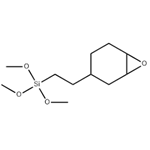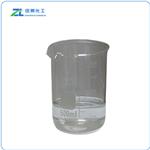Uses
Trimethoxy[2-(7-oxabicyclo[4.1.0]hept-3-yl)ethyl]silane may be used as a precursor to form SiCOH film via sol-gel. The silane may be used to functionalize alumina nanoparticles towards the fabrication of polyamide 12/alumina nanocomposites. 4 Basalt fibers were functionalized with this silane and its consequent effect on the fabrication of basalt fiber–epoxidized vegetable oil matrix composite materials was analyzed.Trimethoxy[2-(7-oxabicyclo[4.1.0]hept-3-yl)ethyl]silane can be used as a silane based coupling agent to functionalize a variety of substrates. It modifies the surface to improve the dispersion of nanoparticles. It can be used as an adhesion promoter by treating the precursor material with epoxy silanes.
Uses
Trimethoxy[2-(7-oxabicyclo[4.1.0]hept-3-yl)ethyl]silane was used as an adhesion promoter during the fabrication of:
- a photoacid generator activated by two photon excitation.
- nanoscale polymeric structures (width: 65 nm) using 520 nm femtosecond pulse excitation.
Trimethoxy[2-(7-oxabicyclo[4.1.0]hept-3-yl)ethyl]silane may be used as a precursor to form SiCOH film via sol-gel. The silane may be used to functionalize alumina nanoparticles towards the fabrication of polyamide 12/alumina nanocomposites. 4 Basalt fibers were functionalized with this silane and its consequent effect on the fabrication of basalt fiber–epoxidized vegetable oil matrix composite materials was analyzed.
Application
Trimethoxy[2-(7-oxabicyclo[4.1.0]hept-3-yl)ethyl]silane was used as an adhesion promoter during the fabrication of:a photoacid generator activated by two photon excitation.nanoscale polymeric structures (width: 65 nm) using 520 nm femtosecond pulse excitation.
Flammability and Explosibility
Non flammable
Synthesis

The apparatus of Example B was charged with 148.8 g (1.2 mol) of 1-vinyl-3,4-epoxycyclohexane, 1.3 g of a carboxylic acid promoter, and 0.15 ml of 10% chloroplatinic acid catalyst solution. The flask contents were heated to 89?? C. and dropwise addition of 122.8 g {[1.0 mol) of trimethoxysilane was begun. The reaction temperature was controlled at 90??-95?? C. with an ice bath. Reaction was maintained at that temperature for half an hour after completion of addition, which took 18 minutes. Analysis by gas chromatography showed a yield of 90% of 2-(3,4-epoxycyclohexyl)ethyltrimethoxysilane. This example demonstrates a standard preparation of 2-(3,4-epoxycyclohexyl)ethyltrimethoxysilane using commercial chloroplatinic acid.
![Trimethoxy[2-(7-oxabicyclo[4.1.0]hept-3-yl)ethyl]silane Structure](https://www.chemicalbook.com/CAS/GIF/3388-04-3.gif)





